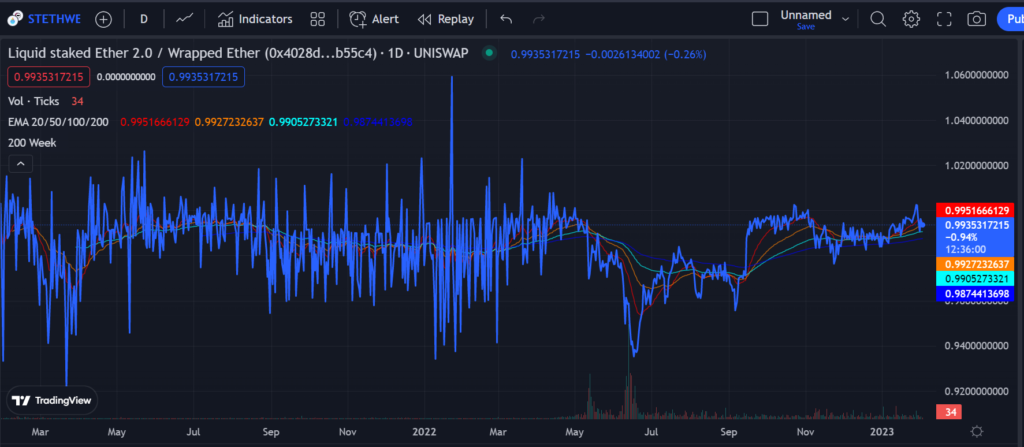stETH has had a persistent discount to ETH, yet it's backed 1:1 and pays a dividend. Inefficient market or justified? I used to be surprised stETH didn’t trade at a premium. But if you break down the embedded risks, the discount is reasonable. This is a framework for thinking about it.
This analysis assumes you know what The Merge and Shanghai upgrade are for Ethereum and what Lido’s stETH is. If you don’t, please read the hyperlinks in the previous sentence and then come back.
I used to be surprised stETH didn’t trade at a slight premium to ETH. stETH is ETH with an embedded dividend that’s effectively the same as ETH due to its 1:1 backing. If stETH’s APR is 4%, you will see that interest payment made via rebasing every day at 12PM UTC. If two stocks have the same claim on assets on the same company, and one pays a dividend and one doesn’t, shouldn’t the dividend-paying one be priced slightly higher to reflect the bond-type payments it provides in addition to its equity claim?
Nominally, it seemed the market disagreed with that assessment. Over the last couple years, the stETH/ETH price ratio has had an equilibrium of around a 1-3% discount. Despite the daily stETH rebase paying 4-7% APR, the market actually assigned a consistently lower value to stETH over the last couple years. Why?

There is a lot of information embedded in price, especially for complex products that have execution expectations built into them. Despite stETH’s 1:1 backing, there is more risk here than meets the eye. In order for the future expectation that stETH is redeemable and backed by ETH to occur, you were and still are making several assumptions (some of these are moot now post-Merge):
- You assume Lido will not get hacked (smart-contract risk): Roughly 31% of all ETH is staked in Lido right now, making it a substantial target.
- You assume The Merge is successful: This officially transitioned Ethereum to a PoS chain and happened Sept 6th 2022, but experienced several delays. There was a non-trivial amount of execution and security risk here, and the uncertainty around its success contributed to the discount.
- You assume the Shanghai Upgrade is successful: This is projected to happen sometime in March or April 2023. Without this upgrade, the ETH backing stETH cannot be withdrawn, giving no hard reason why the 1:1 peg will be arbitraged if it deviates. The longer this upgrade takes, the more smart-contract risk will be embedded into stETH's price; eg if the Shanghai Upgrade is delayed a year, that should discount stETH further.
- You assume the stETH rebasing dividend continues to be paid: Until The Merge, rebasing payments had been coming from Ethereum directly, paying out inflationary rewards to bootstrap staking. If there had been continued Merge delays, Ethereum would have taken on the risk of continuing to pay validators to stake on the Beacon Chain. This is no longer a reason for the discount, but was relevant over the last year or so.
- You assume validators for Lido are honest, competent actors: If many validators consistently go offline or misbehave, the ETH they hold will get slashed, reducing the amount of ETH backing stETH. The risk of this is highly socialized across all stETH holders, so it would take consistent malfeasance for this to impair stETH’s backing, but it’s a relevant consideration.
These are all notable considerations. Some are grey swan events and some are just operational risk, but they deserve to be discounted into stETH’s price.
So what has the market been telling us over the last couple years?
I believe the consistent 1-3% discount is the collective market expectation of these risks manifesting.
I also believe my dividend-pricing assumption is actually being reflected in stETH’s price. But because of the embedded risk we just discussed, the dividend is unable to give stETH a premium to ETH.
My interpretation of the discount is the following: the market is creating an expected value for stETH that factors in the probabilities of these risks. These risks have manifested in a consistent 5-8% discount for stETH’s price vs ETH.
However, when we factor in the embedded dividend for stETH of around 4-7%, we get the persistent stETH market discount of about 1-3%. Meaning, I’d expect stETH to trade around a 5-8% discount sans any rebasing dividend, and with the rebasing dividend it brings it up to 1-3%.
Interpreting the constituent elements of this discount is more art than science, but that's my read. Here’s to Shanghai being a success!
Follow at @BackTheBunny
Check out another one of our popular posts --> In a Multichain Future, Will You Know What Chain You’re Using?



Thanks for sharing. I read many of your blog posts, cool, your blog is very good.
There is definately a lot to find out about this subject. I like all the points you made
Thanks for shening. I read many of your blog posts, cool, your blog is very good. https://www.binance.com/en/register?ref=P9L9FQKY
I truly appreciate your technique of writing a blog. I added it to my bookmark site list and will
There is definately a lot to find out about this subject. I like all the points you made
Good post! We will be linking to this particularly great post on our site. Keep up the great writing
Pretty! This has been a really wonderful post. Many thanks for providing these details.